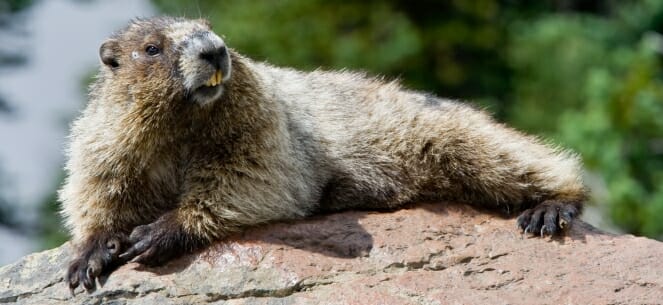
While black bears may be Whistler’s most widely recognized wildlife species, the community is home to a rich abundance of other animals.
Research by the Whistler Biodiversity Project reveals that nearly 4,000 species of animals (vertebrates and invertebrates) are found in Whistler, including mammals, fish, birds, amphibians, slugs, snails, insects and more.
Here is a small sampling of some of the animals found in Whistler:
- Mammals: Black bear, Grizzly bear, cougar, moose, hoary marmot, mountain goat, snowshoe hare, beaver, voles, shrews, weasels, raccoon, red fox, American Pika, mule deer, river otter, bobcat, coyote, several bat species and more.
- Fish: Rainbow trout, Kokanee salmon, Bull trout, Dolly Varden trout and more.
- Birds: Bald eagle, Northern goshawk, Trumpeter swan, Canada goose, Harlequin duck, Great blue heron, Solitary sandpiper, Pileated woodpecker, Horned lark, Grey jay (known locally as whisky jack), Osprey, and many more.
- Amphibians & Reptiles: Coastal tailed frog, Western toad, Northern red-legged frog, Northwestern salamander, Long-toed salamander, Pacific chorus frog, Northwestern alligator lizard and more.
- Bugs, Slugs & Other Invertebrates: Whistler is home to a long list of slugs, snails, spiders, dragonflies, caddisflies moths, beetles, bees, butterflies and more.
View Whistler’s animal species by type:
Inventory and monitoring
Through the Ecosystem Monitoring Program, the RMOW monitors a variety of key indicator species in Whistler including beaver, pileated woodpecker, Rainbow trout, Coastal tailed frogs and red-backed vole.
Through the Whistler Biodiversity Project, the RMOW helps to document as many species as possible in Whistler, including species at risk. The RMOW’s growing understanding of the diversity of species in Whistler’s community helps to inform decision making and guide conservation initiatives.
The RMOW also conducts other field programs such as fish spawning counts and Western toad migration support.
Working with partners
- The RMOW supports the Whistler Naturalists, the Whistler Biodiversity Project and events such as Whistler BioBlitz with funding through the Community Enrichment Program.
- Through a partnership with the Whistler Naturalists, the RMOW monitors various bird species that frequent the Fitzsimmons Creek Delta Bird Sanctuary. This area, a large sandy delta where Fitzsimmons Creek enters Green Lake, provides key habitat for migratory birds, especially shorebirds and water fowl. Such deltas are very rare in the Sea to Sky corridor and provide important areas for nesting, resting and feeding throughout spring and autumn bird migration periods.
- The RMOW works closely with the BC Conservation Officer Service to monitor and communicate dangerous wildlife sightings in Whistler.
- The RMOW actively participates in the BC Species and Ecosystems at Risk Local Government Working Group to collaborate on improving the protection of species at risk in the community.
Policy and planning
- The RMOW works to protect species at risk and other species and their habitat at a policy level, through the Official Community Plan and Development Permit Areas for the protection of the natural environment.
- The Ecosystem Monitoring Program supports policies and objectives related to environmental stewardship and protection of natural areas.
- Whistler has been officially designated as a Bear Smart community. The RMOW is committed to incorporating long-term bear smart practices into community infrastructure, educational programs and resident lifestyles to reduce human-bear conflict.
On the ground
Most of Whistler’s ecosystem and species monitoring work happens on the ground – or in the water. You might see the ecosystem monitoring team doing a variety of wildlife and habitat surveys in the spring, summer and fall.
The RMOW implements species-specific programs to support the conservation of species at risk and other important species. Here are a few examples:
–Black bears: Through the Whistler Bear Advisory Committee, the RMOW works closely with local partners on bear smart initiatives to reduce human-bear conflict.
–Western toads: The RMOW supports the annual migration of western toadlets in Lost Lake Park through park, trail and road closures. Environmental technicians and volunteers monitor the migration and help the toads safely migrate from the lake to the surrounding forest area.
–Grizzly bears: Council recently passed a resolution to support grizzly bear population recovery in the Sea to Sky corridor. The RMOW collaborates with regional partners to support population monitoring and recovery efforts. The RMOW also works to avoid important grizzly bear habitat when planning new recreation trails in backcountry areas.
–Kokanee salmon: RMOW staff and community volunteers conduct annual spawning surveys in various Whistler’s creeks. Surveys are completed to monitor Kokanee populations when they are swimming up the rivers to spawn in the gravel. The River of Golden Dreams (ROGD) is the main river where Kokanee salmon spawn in Whistler. When water levels drop late in the summer, the Tapley’s section of the river is closed for the season in order to protect the spawning gravel for the Kokanee. Often visitors can view the spawning red Kokanee salmon off the ROGD bridge at the end of Lorimer Road.
How can you help?
- Be bear smart! Learn about how you can help keep Whistler’s bears wild.
- Report sightings of rare species or species at risk to the Whistler Biodiversity Project and the BC Conservation Data Centre.
- Download the BC Wildlife Federation’s conservation app to your iPhone to report a wildlife concern.
- Learn more about Whistler’s species and ecosystems by reviewing our Ecosystem Monitoring Program reports (below).
- Volunteer with our Environmental Stewardship team. Email us at stewardship@whistler.ca.
- Participate in local events such as Whistler BioBlitz or the Fungus Among Us Festival hosted by the Whistler Naturalists.
Resources
British Columbia Plants, Animals and Ecosystems
